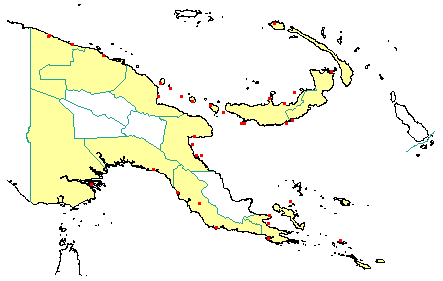
in PNGplants database
PNGTreesKey – Terminalia catappa L. |
Barry Conn (NSW) & Kipiro Damas (LAE).
Guide to trees of Papua New Guinea
Copyright held by the authors, National Herbarium of New South Wales, and Papua New Guinea National Herbarium
Systema Naturae ...Editio duodecima, reformata . (edition 12) Vol. 2: 674 (1767)
Other Literature: M.J.E. Coode, Handbooks of the Flora of Papua New Guinea 72 (1978) Fig. 29.
Family: Combretaceae
Dicotyledon
Timber Group: Occasional timber species (Used for flooring; veneers) Tradename: Red-brown Terminalia
Field Characters: Large canopy tree (up to 30 m high) or Small sub-canopy tree (10-12 m high); Bole cylindrical (20-74 cm diam.); crooked (twisted in coastal habitats) or straight (bole 1-5 m long); buttresses occasionally buttresses present or usually buttresses absent; spines spines absent; aerial roots aerial roots absent; stilt roots stilt roots absent; Bark grey or brown (greyish (sometimes mottled), rough, slightly scaly or flaky, fissured (sometimes (irregularly so), pustular, or sometimes tessellated, lenticels elongated vertically (lenticels pale straw-coloured); Subrhytidome (under-bark) green; less than 25 mm thick, 3.0-5.0; bark blaze consisting of one layer; faintly to non-aromatic; outer blaze red or brown; inner blaze red or brown; terminal buds not enclosed by leaves.
Indumentum: Complex hairs absent; stinging hairs absent; mature twig indumentum (hairs) present when young or later absent, hairs dense to sparse.
Leaves: Leaves clustered at end of branches, spiral (leaves occurring singly at a node and arranged spirally up the branchlet), simple (a leaf composed of a single blade); petiole present, not winged, attached to base of leaf blade, not swollen; leaves broadest above middle, 17.0-29.0 cm, 10.0-15.0 cm; symmetric, entire, not dissected or lobed, obtuse to acute, venation pinnate, secondary veins open, prominent, intramarginal veins absent; leaves lower surface pale green (veins yellowish), upper surface dark green (glossy (usually), indumentum (hairs) absent when mature or present when immature, indumentum (hairs) dense to sparse; absent; domatia absent; stipules absent.
Flowers: Inflorescence terminal and axillary, flowers on an unbranched axis, cones absent; flowers unisexual and bisexual, unisexual with male and female flowers on the same plant, stalked, flowers with many planes of symmetry, 3.0-5.0 mm long, diameter small (up to10 mm diam.); perianth present, with all sepals and/or petals (hence tepals) similar, inner perianth white; 5, some or partly joined; stamens 10, present, free of each other, joined to the perianth; ovary inferior, carpels joined (when more than one), locules 1; styles solitary, 1.
Fruits: Infrutescence arranged on unbranched axis, fruit 55.0-70.0 mm long, rarely yellow or red, not spiny, non-fleshy or fleshy, simple, indehiscent, drupe; seeds 1, much more than 10 mm long (including dense hard stone), winged, broad (as wide as long), seed 1-10 mm diam.
Distribution: West Sepik, East Sepik, Madang, Morobe, Western, Gulf, Central, Milne Bay, Papuan Islands, New Britain & New Ireland.
 | Botanical records in PNGplants database |